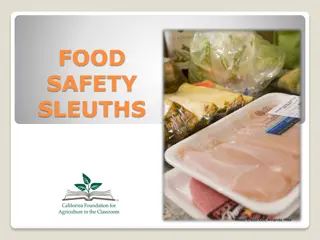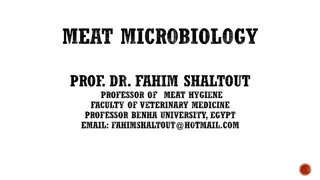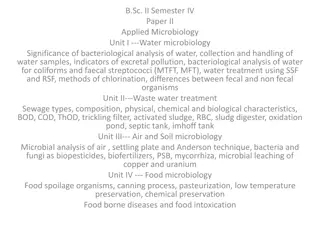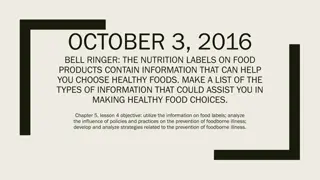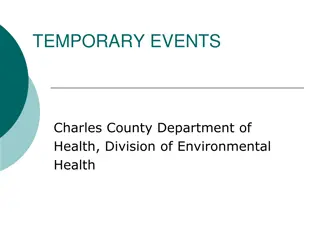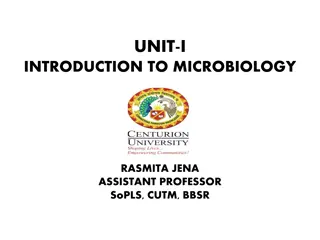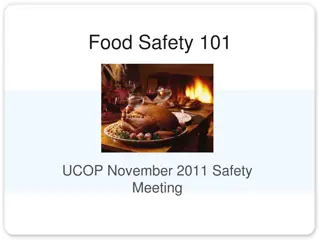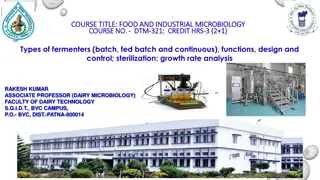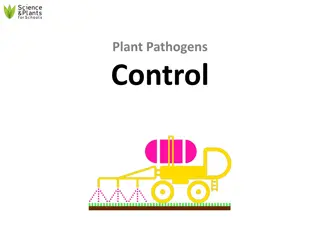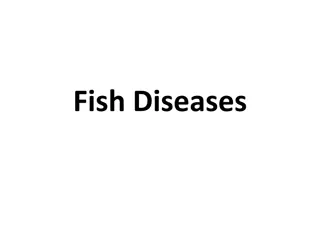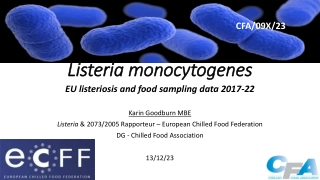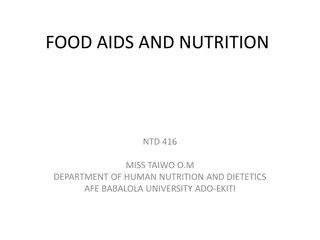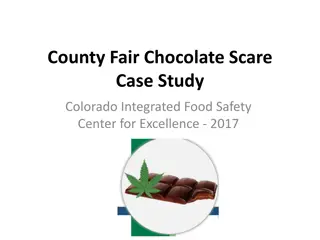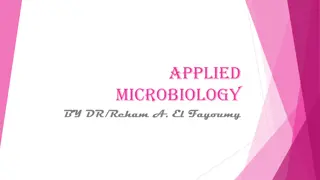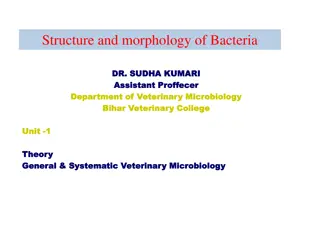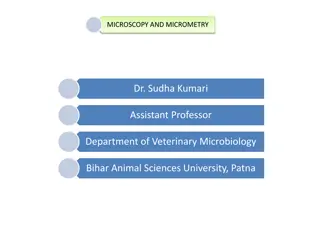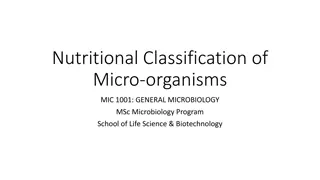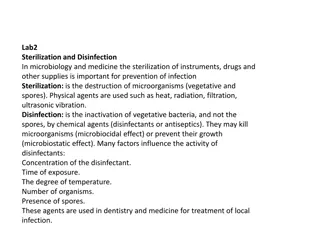Understanding Microbiology of Food and Foodborne Diseases
This introduction delves into the world of microbiology in relation to food, exploring key terms such as foodborne diseases, food hygiene, contamination, and more. It covers crucial concepts like toxic-infection, carriers, pathogens, and vectors, shedding light on the importance of food safety practices to prevent illness outbreaks.
Download Presentation

Please find below an Image/Link to download the presentation.
The content on the website is provided AS IS for your information and personal use only. It may not be sold, licensed, or shared on other websites without obtaining consent from the author. Download presentation by click this link. If you encounter any issues during the download, it is possible that the publisher has removed the file from their server.
E N D
Presentation Transcript
INTRODUCTION INTRODUCTION TO MICROBIOLOGY OF FOOD MICROBIOLOGY OF FOOD TO (MCB 202)
TERMINOLOGY Food: any substance, whether raw, processed, semi processed that is intended for human consumption, including drinks, and any substance that has been used in the manufacture, preparation or treatment of food. But excluding substances only used as drug. Foodborne disease: any disease of an infection or toxic nature caused by the consumption of food. Foodborne disease outbreak: various definition are in use; a. When the observed number of cases of a particular disease exceeds the expected number. b. the occurrence of two or more cases of a similar foodborne disease resulting from the ingestion of a same food. Foodborne intoxication: illness caused by ingestion of toxins produced in food by bacteria as a naturally occurring by-products of their metabolic processes cosmetics, tobacco and
Toxico-infection: illness caused by ingestion of an infectious agent that produces a toxin in the body (as opposed to in the food) Food hygiene: all conditions and measures necessary to ensure the safety and sustainability for consumption of food at all stages of its growth, distribution and preparation. Food Hazard: a biological, chemical or physical agent in or property of food that may have an adverse effect. Infection: The entry and development microorganism in the body of persons or animals. Incubation period: the time interval between the initial contact with an infectious agent and the first appearance of symptoms associated with the infection. or multiplication of
Contamination: Microbiological presence of microorganisms on objects, in the environment, or in samples for analysis. Thus food contamination is the presence of a disease agent on or in food or any object that may come in contact with food Carrier: An individual showing no sign and symptom of infection but harbours an infectious agent which may be harmful when passed to another person. Reservoir of infection: ecological niche in which a pathogen lives and multiplies and upon which it depends for its survival. Reservoir include human reservoirs, animal reservoirs and environmental reservoirs. Vector: an animate intermediary in the indirect transmission of an agent that carries the agent from a reservoir to a susceptible host.
Vehicle: an inanimate intermediary (e.g. food) in the indirect transmission of an agent that carries the agent from a reservoir to a susceptible host. Toxin: A poisonous substance produced by a living organism. Toxicant: A poisonous substance prepared by man. Parasite: An organism that lives in or on another species or creature and obtains food and shelter without benefiting but rather harming the host. Pathogen: An organism which pathogen. Pathogenicity: ability or capacity of an organism to cause disease. Virulence is the degree or intensity level of a pathogen. produces disease is called
Endemic: the constant presence of a disease within a given geographical area or population group. Epidemic the occurrence of cases of an illness clearly in excess of expected rates; often referred to as an outbreak (a more neutral term). Pandemic: An epidemic disease that occurs worldwide. Sporadic disease: A disease which is found here and there at intervals. Epidemiology: The study of occurrence of disease; tells the when (time), where it occurs (place), how it was transmitted (aetiology) and Who it affected (person). Incidence: number of new cases in a population in a defined period of time. Prevalence: the number or proportion of cases in a defined population.
FOOD SPOILAGE Food spoilage is defined as damage or injury to food rendering it unsuitable for human consumption. Food is spoilt if it is contaminated microorganisms or various pesticides, heavy metals etc. In most cases the food might look normal with no evident sign of spoilage but only after eating it or by careful bacteriological and toxicological investigation, one is able to realize the defect/spoillage. Food decay or decomposition is implied when the term spoiled is used. with pathogenic agents, poisonous such as
CAUSES OF FOOD SPOILAGE 1. physical changes; 2. Enzyme action 3. Chemical reaction 4. Vermins (insect, rodents and other wild mammals etc) 5. Microbial contamination 1. Physical changes These include those changes caused by freezing, burning, drying, pressure, etc. Water/moisture loss (drying) mainly affects fruit and vegetables. The moisture is lost through skins and leaves and this cause wrinkling, shrinkage and limpness.
2. Enzyme action Action of enzymes found inherently in plant or animal tissues start the decomposition of various food components after death of plant or animal. Ripening: Enzymes cause food to ripen, then become over- ripe and eventually decay. Starch changes to sugar, colour changes and texture softens. Browning: When certain foods are cut and the surface exposed to air, enzymes cause them to turn brown. e.g. apples, Enzymatic rotting: Enzymes in fish cause deterioration even at low temperatures.
Prevention: heating (cooking and canning); Freezing (cold temperature slows enzyme action) enzyme in vegetable work at low temperature, so must be blanched before freezing. Chemical prevention (acid inactivates enzyme) 3. Chemical reaction These are reactions that are not catalysed by enzymes.,e.g. oxidation of fat. 4. Vermin Vermin includes weevils, ants, rats, cockroaches, mice, birds, larval stages of some insects. Vermin are important due to: (i). Aesthetic aspect of their presence, (ii) Possible transmision of pathogenic agents, (iii). Consumption of food.
5. Microbial Food Contamination This is the presence of a disease agent on or in food or any object that may come in contact with food. Bacteria, yeasts and molds are microorganisms that cause food spoilage. They produce various enzymes that decompose the various constituents of food. Molds are the major causes of spoilage of foods with reduced water activity e.g dry cereals and cereal product Bacteria spoil foods with relatively high water activity such as milk and products.
Sources of microbial contamination - Raw foods may be contaminated at their source with microbes such as Salmonella, Campylobacter, Clostriduim perfrigens, Staphylococcus aureus, etc. this raw foods include raw meat, raw fish, grains (rice and others), herbs and spices. - Foods were obtained from unsafe sources (raw milk, raw egg, mushrooms, etc). - Non-portable water used in food preparation. - Infected persons (e.g a nasal carriers of Staph. aureus, persons in the incubatory phase of hepatitis A, persons infected with norovirus and intestinal carriers of Shigella). - Contaminants were spread by workers hands, cleaning cloths
or equipment, from raw foods of animal origins to cooked foods or to foods that were no subjected to further heat treatment. - From equipment that were not properly cleaned (e.g. slicers, grinders, cutting boards, knives, storage containers). - Food may become contaminated during storage, e.g. through exposure to leaking or overflowing sewage. - Food may be contaminated by sewage during growth or production.
FACTOR INFLUENCING THE GROWTH OF MICROORGANISMS IN FOODS. Foods, because they provide nutrients for us, also are excellent environments for the growth of microorganisms. Microbial growth is controlled by factors related to the food itself (intrinsic Factors), and also to the environment where the food is being stored or prepared (extrinsic factors) INTRINSIC FACTOR (food-related factor) -moisture content -water availability or activity -oxidation reduction potential -physical structure of food -ph. -available nutrients -biological barriers -possible presence of natural antimicrobial agents EXTRINSIC FACTOR (environmental factor) -storage temperature -Relative humidity -gases (CO2, O2) -types an numbers of microorganisms present in the food
Food serve as vehicles for transmission of disease because they are all nutrient-rich excellent environments for the growth of microorganisms Foods consisting carbohydrates mainly (e.g. breads) undergo spoilage by fungal growth rather than bacterial. There growth predominates an spoilage does not result in major odours. Foods containing large amount of protein and/or fats (e.g meat) undergo spoilage by bacterial growth. There growth predominates and the spoilage produce variety of foul odours. Degradation of fats ruins food Yeasts and molds thrive favourably in food with low pH while in foods with neutral or alkaline pH bacteria are more prevailing in spoilage and putrefaction.
The presence of water in food affects the ability of microorganisms to colonize foods. Osmophilic microbes grow best in food with high water activity while xenophilic microbes grow best in food with low water activity (dry food). Water in food can be made less by addition of solutes such as salt or sugar. A lowered Oxidation-reduction environment for microbial growth. Cooking of food lowers its oxidation-reduction potential. Physical structure of food affect the course and extent of spoilage. Grinding and mixing of foods not only increases the food surface area but also distribute contaminating microorganisms throughout the food which result in spoilage if the food are not properly stored. The outer skin of vegetables and fruits protect them from spoilage. present a reducing
Many foods have natural antimicrobial substances, complex chemical inhibitors and enzymes. E.g eggs are rich in enzyme lysozyme that can lyse the wall of contaminating gram- positive bacteria. Coumarins in fruits an vegetables exhibits antimicrobial activity. Herbs and spices have significant antimicrobial substances which fungi are more sensitive to than bacteria. Garlic contain allicin, cloves which are microbial inhibitors. Several studies have shown that spices also can contain pathogenic an spoilage organisms. Unfermented green and black tea also have antimicrobial properties because of their polyphenol contents. Such unfermented tea are active against bacteria, viruses and fungi and may have anticancer properties.
Temperature and relative humidity are important extrinsic factors in determine whether a food will spoil or not; at lower temperature or higher relative humidity, microbial growth is initiated more rapidly (esp when refrigerator are not maintained in defrosted state). Herbs and spices have significant antimicrobial substances which fungi are more sensitive to than bacteria. Garlic contain allicin, cloves which are microbial inhibitors. Several studies have shown that spices also can contain pathogenic an spoilage organisms. Unfermented green and black tea also have antimicrobial properties because of their polyphenol contents. Such unfermented tea are active against bacteria, viruses and fungi and may have anticancer properties.
Controlling food spoilage Contamination often occurs after preparation, during packaging or when can is opened and just before the food is served. This can provide an ideal opportunity for growth and transmission of pathogens, if care is not taken . It is vital to eliminate or reduce the populations of spoilage and disease-causing microorganisms and to maintain the microbiological quality of a food with proper storage and packaging. Foods can be preserved by a variety of methods. 1. Removal of microorganisms 2. Low temperature 3. High temperature 4. Water availability 5. Chemical based preservation
Removal of microorganisms Microorganisms can be removed from water, wine, beer, juices, soft drinks, and other liquids by filtration. This can keep bacterial populations low or eliminate them entirely. Pre-filters and centrifugation often are used to maximize filter life and effectiveness. Several major brands of beer are filtered rather than pasteurized to better preserve the flavor and aroma of the original product. Low Temperature Refrigeration at 5 C retards microbial growth, although with extended storage, psychrophiles and psychrotrophs will eventually grow and produce spoilage. Slow microbial growth at temperatures below 10 C has been described, particularly with fruit juice concentrates, ice cream, and some fruits. Some microorganisms are very sensitive to cold and their numbers will be reduced, but cold does not lead to significant decreases in overall microbial populations
High Temperature Controlling microbial populations in foods by means of high temperatures can significantly limit disease transmission and spoilage. Heating processes provide a safe means of preserving foods, particularly when carried out in commercial operations. This is done with canning and pasteurization. Canning food is heated at about 115 C for intervals ranging from 25 to over 100 minutes. The precise time and temperature depend on the nature of the food. However, sometimes canning does not kill all the microorganisms, but only those that will spoil the food (remaining bacteria are unable to grow due to acidity of the food. Pasteurization involves heating food to a temperature that kills disease- causing microorganisms and substantially reduces the levels of spoilage organisms. It is used in production of milk, beers, and fruit juices. In home processing of foods, especially less acidic foods such as green beans, fish or meats can be preserved and the microorganisms destroyed by heat.
Despite efforts to eliminate spoilage microorganisms during canning, sometimes canned foods are spoiled. This may be due to spoilage before canning, underprocessing during canning, and leakage of contaminated water through can seams during cooling. Water Availability Dehydration, such as lyophilization (a low temperature dehydration process also called freeze drying) is used to produce freeze-dried foods and eliminating microbial growth. This is a modern process, an update of older procedures in which grains, meats, fish, and fruits were dried. It is used to preserve perishble materials, to extend shelf life pr make material more convenient for transport.
Chemical-Based Preservation Various chemical agents can be used to preserve foods. They include simple organic acids, sulfite, ethylene oxide as a gas sterilant, sodium nitrite, and ethyl formate. These chemical agents affect microorganisms by disrupting a critical cell factor. For example, they may damage the plasma membrane or denature various cell proteins; interfere with the functioning of nucleic acids, thus inhibiting cell reproduction. The effectiveness of many of these chemical preservatives depends on the food pH. Assignment: Assignment: List 10 chemical agents used for food preservation, mention at least 5 foods List 10 chemical agents used for food preservation, mention at least 5 foods each agent help preserve. And one organisms affected. each agent help preserve. And one organisms affected.
Radiation preservation. Ultraviolet radiation is used to control populations of microorganisms on the surfaces of laboratory and food-handling equipment, but it does not penetrate food. The major method used for radiation sterilization of food is gamma irradiation from a cobalt-60 source. This electromagnetic radiation has excellent penetrating power and must be used with moist foods because the radiation produces peroxides from water in the microbial cells, resulting in oxidation of sensitive cellular constituents. Radappertization, is also extend the shelf life of sea foods, fruits, and vegetables. Also to sterilize meat products. However, some microorganisms are radiation-resistant e.g Deinococcus radiodurans, this bacterium has a complex cell wall structure and tetrad-forming growth patterns. It also has an extraordinary capacity to withstand high doses of radiation. Ionizing and non-ionizing radiation are used for food
Microbial ProductBased Inhibition This involve the use of bacteriocins for the preservation of foods. Bacteriocins are bactericidal proteins active against closely related bacteria, which bind to specific sites on the cell, and affect cell membrane integrity and function. The only currently approved product is nisin. Nisin, produced by some strains of Streptococcus lactis, is a small hydrophobic protein. It is nontoxic to humans and affects mainly gram-positive bacteria, especially Enterococcus faecalis. Nisin can be used particularly in low- acid foods to improve inactivation of Clostridium botulinum during the canning process or to inhibit germination of any surviving spores. Bacteriocins function by dissipating the proton motive force (PMF) of a susceptible bacterium. Bacteriocins function by inhibiting peptidoglycan synthesis and detergent-like effects on the cytoplasmic membrane. Bacteriocin is used in the preservation of cheese where it can result in two- to threefold reduction in Listeria monocytogenes in 180-dayold cheeses.
FOODBORNE DISEASES Foodborne diseases is any disease of an infection or toxic nature caused by the consumption of food. Since 1942, the number of recognized food-borne pathogen has increased over double. There are two types of food borne related diseases: food borne infection food intoxication. NOTE: all of these food borne diseases are associated with poor hygiene practices. Whether by water contamination or food transmission, the faecal route is maintained with food providing the vital link between hosts. Fomites such as sink faucets, drinking cups and cutting boards also play a role in the maintenance of fecal-oral route of contamination
Foodborne infection: A food borne infection involves the ingestion of the pathogen followed by growth in the host, including tissue invasion and/or the release of toxins. The major diseases of this types are summarised below Food borne intoxications Microbial growth in food products also can result in food intoxication. intoxication produces symptoms shortly after the food is consumed because growth of the diseases causing microorganisms is not required. Toxins produced in the food cab be associated with microbial cells or can be realised from the cells.
Major food borne infectious diseases Diseases Organism Incubaton period and characteristics 8-48 hours Enterotoxin and cytotoxins Major food involved` Meats, poultry, fish, eggs, diary products Salmonellosis S. Enterica serovars Typhimurium and Enteritidis Arcobacter butzleri Campylobater jejuni L. Monocytogene s Arcobacter diarrhea Campylobacterio sis Listeriosis Severe Diarrhea, recurrent cramps Usually 2 10 days Meat products, especially poultry Milk, pork, poultry products, water Meat products especially pock and milk Varying period Related to meningitis and abortion; New-borns and elderly esp susceptible 24-72hrs Enterotoxigenic positive and negative strains; hemorrhagic colitis Escherichia coli Diarrhea and colitis E.coli, including serotype 0157:H7 Undercooked ground beef, raw milk
Shigellosis Shigella sonnei, S. fleneri Yersinia enterocolitica Plesiomonas shigelloides V. Parahaemolytic us 24-72hrs Egg products, puddings Milk, meat products, tofu Uncooked molluscs Yersiniosis 16-48hr Some heat stable toxin 1-2hr Plesiolonas diarrrhea Vibrio paraheamolyticu s gastroenteritis 16-48hr Seafood, shell fish
Detection of food-borne pathogens A major problem in maintaining food safety is the need to rapidly detect microorganisms in order to curb outbreak that can affect large population. This is especially important because of the wide scale of distribution of perishable foods. Identification includes: 1. Standard culture technique 2. ELISAs enzyme-linked immunoassays 3. Fluorescent antibody 4. Radioimmunoassay techniques 5. Molecular techniques- are of increasingly used and very valuable for 3 purposes i. It can be used to detect the presence of a single specific pathogen ii. To detect viruses that cannot be grown conveniently iii. To identify slow growing or non cultivable pathogens


